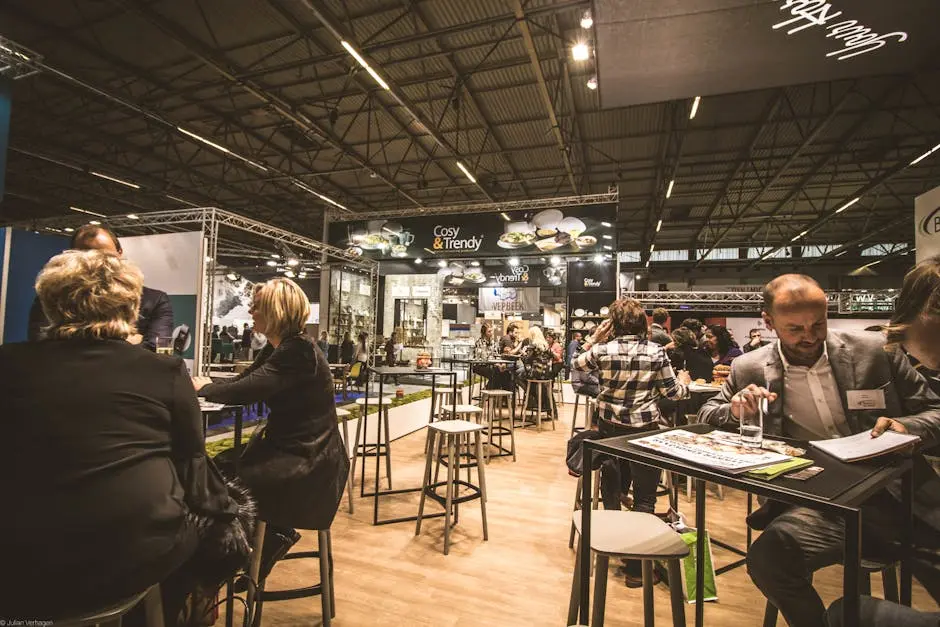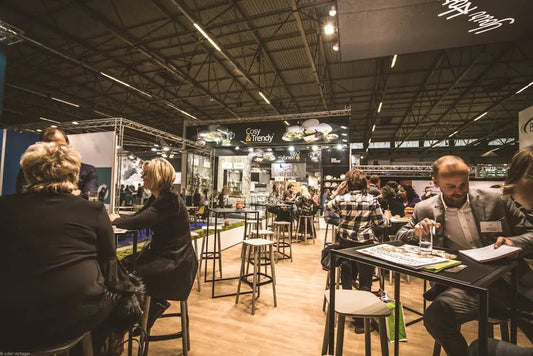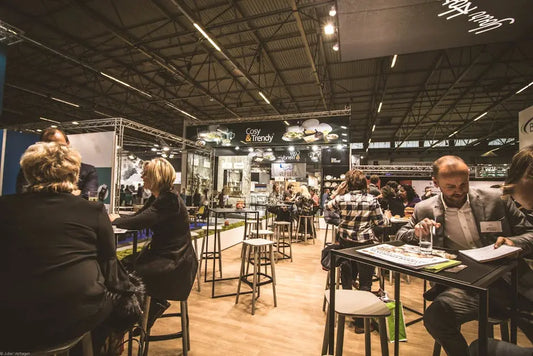Trade shows offer a fantastic opportunity to showcase your brand and attract potential clients or partners. However, with many companies trying to capture attention, it’s crucial that your display stands out. In this blog post, we’ll explore essential tips for designing a display that is eye-catching and impactful.
Understanding the Purpose of Your Display
Before you start designing your display, it’s important to have a clear understanding of your goals. Are you looking to generate leads, launch a new product, or simply raise brand awareness? Knowing your objectives will guide every decision you make. Tailoring your approach can significantly impact how attendees perceive your brand. For instance, if brand recognition is your focus, consider including vivid, consistent branding elements across your booth. However, if lead generation is the key aim, integrating digital signup methods might be more effective. By laying out these fundamental goals, you’ll provide a roadmap to success and a level of cohesion throughout your setup.
Identifying your main objectives helps streamline your display design. If customer interaction is important, ensure there are spaces designed for personal engagement. Alternatively, for product-focused exhibits, prominently display your lineup with convenient access for attendees to see and explore. Each choice you make in service to your primary purpose is a step towards creating a powerful and memorable presentation, leading to a more defined path post-event where success is measured.
Each goal requires tailored planning and execution strategies. Whether showcasing pioneering technologies or simplicity in an everyday product, your goals strongly influence the visual, tactile, and emotional elements of your display design. Always ensure your display settings are adaptable, with attainable objectives, and communicate your story effectively. A strategic initial outline aids in clearly articulating your envisioned success.
Design Fundamentals: Bold and Simple
When it comes to design, less is often more. Use bold colors and simple messaging to catch the eye. Your design should be easily understood from a distance and invite attendees to get a closer look. Incorporate mascots, brand icons, or memorable slogans that are part of your visual identity consistently across all your elements. Utilizing bold designs ensures quick, impactful recognition and encourages closer scrutiny as they interlope within the engaging context provided by the surrounding elements.
The challenge is in balancing bold features with simplicity to avoid clutter. While bold colors and high-contrast layouts naturally draw attention, they must be strategically used so they do not overwhelm or cause visual fatigue. Economizing visuals not only enhances the overall aesthetic but helps achieve a professional appearance that is clean and approachable. Consider using simple iconography or relatable images that convey your message instantly. Simplifying elements often highlights crucial aspects of your products or services.
Moreover, implementing a simplistic design can suggest a forward-thinking approach to current trends. Modern trade show participants are often overexposed to information, and concise design principles can deliver key messages delightfully. Embrace whitespace and precision—these design solutions exploit visual language efficiently, embodying a sophisticated allure without the need for excessive complexity. For unique inspiration, designing trade show booth graphics in a fun and informative way can aid in striking the right balance.
Incorporating Interactive Elements
Interactive elements such as demos, games, or touchscreens can create memorable experiences for attendees. These engagements can spark conversations and provide valuable opportunities to connect with potential customers. Involving attendees throughout the engagement process builds a personal connection with your brand, nurturing an atmosphere of curiosity and increased visibility. A well-chosen interactive element provides exclusive insights into company values, while aiding cross-sector networking.
Crafting opportunities for engagement can occur through various means, from live demonstrations to experiential interactions depending on the nature of your product or message. By establishing supplement platforms such as virtual realities and social media challenges, attendees are drawn deeper into your brand landscape, generating dialogues and interactions extending past the show duration. These anchoring elements transform passive experiences into lively interactions, aiding resonance and memory retention.
Effective Use of Lighting and Visuals
Proper lighting can dramatically enhance your display’s appeal. Consider using spotlights to highlight key features and make sure your visuals are high-quality and relevant. This can help draw attention and add depth to your setup. Strategic placement of lights can be both theatrical and subtle, playing into dynamic visual storytelling. Overhead lighting adds a layer of transparency, illuminating your layout with a natural appeal that simulates open, active spaces.
Recognizing different presentation periods throughout the day can affect how visuals connect with your audience efficiently. Background lighting that shifts from cooler to warmer tones may influence mood and perception, ensuring sustainable engagement. Always marry lighting with visuals to bring out dynamic vibrancy, keeping the representation crisp and clear around your central message.
Additionally, integrating digital displays with dynamic lighting solutions adds a contemporary element to your booth, allowing you to illustrate a constantly evolving narrative. Capturing attention translates into an appeal that grows and remains consistent throughout show times. Opting for high-luminance displays enhances differentiation, drawing organic walk-ins and encouraging sustained interactions through natural intrigue.
Telling Your Brand Story
Your trade show display should tell a compelling brand story. Use visuals, infographics, and testimonials to communicate your brand values and mission. Sharing your story can create a strong connection with your audience. Incorporate eye-catching graphics and cohesive designs to communicate your core values effortlessly, ensuring coherence across show materials as they narrate everything your business embodies.
Focus on maintaining a captivating narrative, whether that’s with an evocative timeline marking your achievements or showcasing milestones through experiential displays. Wrap these components in engaging formats to immerse your audience, leading them through a journey rather than a static snapshot. Constructing your story helps attendees visualize their alignment with your values, often turning casual observers into more invested parties.
Inviting attendees to dive into your story happens when exhibitors portray authentic stimuli that audiences can resonate with—those that emit a personal connection to their individual passions and aspirations. Strive for authenticity that celebrates uniqueness yet radiates universal themes that generate common ground. It is these connective moments that empower brand loyalty, persisting beyond the bustling trade floor. Explore creative ordeals that encourage attendees to tie back to familiar concepts found in their everyday experiences.
Training Your Team for Engagement
Your team is your greatest asset at a trade show. Ensure they are well-trained and enthusiastic about interacting with visitors. A knowledgeable and friendly team can greatly enhance the effectiveness of your display. Engaging dialogue ensures relatability and adaptability in real-time situations, harnessing each encounter into a potential opportunity. Coordinating team uniforms or paraphernalia can extend your brand message through professionalism and consistent styling.
Training programs focused on product knowledge, soft skills, and quick problem-solving are pivotal in refining your imprint on every potential contact that passes through. Consider role-playing situations your team might encounter during events to prepare for spontaneity while keeping your brand ethos grounded in every interaction. Great interaction brings value and accessibility, subtly reinforcing representation as each engagement proceeds.
Encouraging your staff to make well-informed suggestions, assist actively, and present themselves as approachable promotes an inviting aura. Additionally, their presence should highlight strategic axes balanced between heritage and advanced trends—attendees should leave with an understanding of your organization’s tradition as well as innovation aspirations. With assorted responsibilities, handling nuances of behavior becomes an intuitive effort, augmenting your brand’s attribute of personability throughout the trade show.
Conclusion: Stand Out on the Trade Show Floor
Creating an eye-catching trade show display doesn’t have to be daunting. By focusing on clarity, engagement, and professionalism, you can design a booth that not only draws in visitors but also leaves a lasting impression. Remember to incorporate strong visuals, interactive elements, and your unique brand story to truly stand out. For insights on innovative trade show solutions, visit our homepage today.



